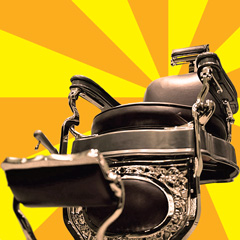Lessons in Customer Experience From a Hair Salon
 When was the last time someone told to you about his or her customer experience at a hair salon? This short service story illustrates what a great customer experience can do and provides a few lessons many organizations can learn from.
When was the last time someone told to you about his or her customer experience at a hair salon? This short service story illustrates what a great customer experience can do and provides a few lessons many organizations can learn from.
My friend Tim recently decided he needed a haircut. His hair is generally short, and wanting just a simple cut, nothing fancy, he usually just goes to one of these inexpensive hair salons that offer standard cutting, coloring and styling. There are many of them conveniently located near his work, but they are indistinguishable from one another, all offering the same type of services for about the same price. So he just picked one at random.
Without any specific style in mind, Tim told the stylist he just that he wanted his hair shorter. The stylist suggested cutting the hair shorter on the sides and leaving it a bit longer on the top to allow for different styling options. As it is customary, Tim was sent to get a hair wash before the cutting started. During the cutting, the stylist checked a few times with Tim if the length was OK and made a few adjustments. When it was satisfactory, Tim went for a rinse to get the loose hair out for final adjustments and a blow-dry. It’s a banal story but what followed goes beyond the usual routine. The stylist explained to Tim that with this cut he could style his hair a few different ways; blow-dried and natural like it was then or using wax or gel to comb it sideways or prop it up. He then proceeded to actually show Tim how to do it, first using gel, then using hair wax, and sending him for another hair wash and blow-drying his hair between each styling. It may not seem like much, but this greatly increased the perceived value received; three different haircuts for the price of one, with styling lessons included. That’s a lot more than “just shorter”.
On leaving, the satisfied customer paid the advertised price and gladly added 35% on top, even if tip was not required.
The experience was exceptional enough that Tim wanted to share it with someone, so he called me. He shared it with me admittedly partly because he knows I love these kinds of service stories but the point is that not only will he return there next time he needs a haircut but when the occasion comes up, he will share his experience with others and recommend the place.
To give that level of service, I thought, the place must have been really empty (like most of the salons nearby are). As it turns out, it was packed. And that makes sense.
This is just a simple anecdote but it serves as a reminder of a few broad concepts in customer experience. Although from a small hair salon, the lessons can be applied to organizations of any size and in multiple industries.
- Customer experience is a differentiator. Especially in a commoditized market in which competitors offer pretty much the same products and services, the customer experience is what makes an organization stand out, and can lead to customer loyalty. Companies in multiple industries are starting to realize this and are making customer experience their top priority.
- More than loyal customers, exceptional customer experiences can create promoters. Beyond increasing the chances of repeat business, an exceptional customer experience can turn customers into promoters who will recommend the company to others.
- Keeping customers involved and informed during the service delivery process can increase satisfaction (it at least avoids or mitigates unpleasant surprises). The stylist in this story informed the customer beforehand what he would do, got the customer agreement along the way and explained again at the end what he did. The healthcare industry in particular could learn from this one.
- Delivering value beyond expectations enhances the customer experience. This doesn’t mean it needs to cost the organization more. Sometimes it is about perceived value. In the example above, the customer just wanted his hair shorter. What he got seemed to him much more than what he originally wanted.
- Superior customer experiences can command a premium. Some people are willing to pay more for a better customer experience. Charging a premium for better customer experiences may not be the best business strategy for every organization but in service industries that rely on gratuities, delivering a good customer experience increases staff wages. And although the story doesn’t tell, this in turn means higher employee engagement and less employee turnover.
Tagged: | Customer Experience
David Jacques is Founder and Principal Consultant of Customer input Ltd and a pioneer in the field of Customer Experience Management. He has created the first Framework that brings together cohesively every aspect of Customer Experience Management. He is also passionate about having an in-depth understanding customer values to create emotionally-engaging customer experiences not only at individual interactions but also seamlessly between them.
All posts by David (30) - Connect on: LinkedIn - Twitter
